Elbingeröder complex

The Elbingeröder complex is a geological building unit in the Harz Mountains . As Elbingeröder complex is an isolated stromatoporoids - coral - coralline algae - reef within the Blankenburger zone designated. The reef is formed from Devonian to Sub-Carboniferous rocks and, due to its development history, represents a special facial development within the Harz geology.
Geographical expansion
The Elbingeröder complex is located in the Middle Harz and extends 18 km in an east-west direction - from Königshütte - Mandelholz to Hüttenrode and a maximum of 4.5 km in a north-south direction - from Büchenberg to Bode . The limestone distribution areas are largely unforested and have a characteristic limestone flora and fauna. A 420 ha area between Elbingerode and Hüttenrode is an area with species - rich semi -arid grasslands , rock corridors, mountain meadows, grass grass and near-natural forests. Partly protected as a priority habitat as Natura2000 area.
Geological evolution
The special development within the Blankenburg zone begins in the Eifelium with the submarine deposition of the first volcanic rocks . These volcanics, formed from shell stones , spilites , keratophyres and diabase , reach a thickness of 500 to 1000 m and are assigned to three different production phases: an early and main phase in the Devonian and the deck diabase in the Lower Carboniferous. The submarine flare was carried out from gaps at points of intersection of Erzgebirgisch and flat herzyn sweeping disorders underground. The volcanic structures reached in the form of crevice volcanoes , upper, light-flooded and well-ventilated sea areas and thus created an initial reef growth.
During the pauses in volcanic activity, the first reef limestone formed on the Eifelium / Givetium border . The actual reef growth began after the extinction of volcanism in the middle Givetian and continued up to the Frasnium / Famennium border. At the same time, the reefs die worldwide during this time. In the Elbingeröder complex, the reef died out over a longer period of time, differentiated in time and space.
Even after the actual reef development, limestone can be found in so-called Neptunian corridors , which, however, differ fundamentally from reef limestone. These Neptunian corridors are multi-phase filled in the Elbingeröder complex and are to be regarded as carbonatic formations of submarine deep sills. The most recent carbonate formations are known from the Lower Carboniferous ( Dinantium ).
In the famennium , cephalopod limestone and predominantly red clay stones were deposited in the peripheral areas . With the transgression of the rocks in Kulm facies (Kulmbach chert , Kulm shales, Kulmbach grauwacke ) and the superposition of the Kalkriffes through the cabin Röder olistostrome ends facies special development in the area of the Elbingeröder complex.
During the Cretaceous / Tertiary weathering , the limestones were deeply karstified and typical karst forms such as sinkholes , ponors and stalactite caves were formed . The most famous stalactite caves, the Hermanns and Baumanns caves, are open to visitors as show caves in Rübeland . In the limestone quarries, sinkholes filled with loess clay can often be seen at the edge of the quarry.
Structural structure
The Ebingeröder complex is divided internally by four wide Schalstein saddles and three narrow Kulm hollows . From north to south they are
- the Büchenberg saddle,
- the Ahrenfeld-Mulde,
- the Elbingeröder saddle with the Königshütter saddle and Hornberg-Horst,
- the Elbingeröder Mulde,
- the brown swamp saddle with the Großer Graben Horst,
- the Rübeland-Hüttenröder Mulde and
- the Neuwerk saddle with the Stahlberg Horst.
Lateral architectural changes can be observed within the tectonic building units . T. by stroking in Horst structures. The central part of the complex is Elbingeröder grave like to flachherzyn striking depth disorders decreased, with the Bode - lineament communicate. This fault zone, which can be tracked supraregionally, is also reflected in the differences in the facials with regard to mineralization, silicification and the distribution of the Neptunian veins as well as the tertiary sediment formation.
Economical meaning
Red iron ores near the surface were mined in the Elbingeröder complex at the latest since the 12th century. The red iron ores belong genetically to the sedimentary-exhalative deposits of the Lahn-Dill type and are linked to the transition from the volcanic rocks to the early reef limestone formations. The early mining took place in Pingen in the area of Volkmarskeller , on Büchenberg and in Almondwood.
The red iron ore mines Braunesumpf and Büchenberg , which were among the most important iron ore deposits in the GDR and were closed in 1969 and 1970, respectively, were of supraregional importance . The iron ores differed in terms of mineral paragenesis in both pits : while in the Braunesumpf mine near Hüttenrode mainly magnetite - siderite - chlorite ores were mined, the Büchenberg deposit was characterized by the predominance of pebbly and hematitic iron ores.
Until the political change , iron ore was still extracted in the area of the Great Rift between Elbingerode and Rübeland. At first, old mining used limonite iron ores in open-cast mines and pingen. In the 20th century, vanadium-rich pyrite ores of the Rio-Tinto type were mined in the pit unit to a depth of 480 m. The mine unit was closed on July 31, 1990 and was partially used as a visitor mine until November 2015 . Brown iron stones near Susenburg , which were formed by tertiary weathering processes, were of local importance in the past .
In addition to iron ores, in the Elbingerode complex there was brief mining of pebbly manganese ores in Schävenholz, 2 km northwest of Elbingerode. The ore horizon, which was no more than 10 m thick, was genetically linked to the lower Carboniferous Kulm gravel slate. Between 1980 and 1990, rhodonites from sheep wood were processed into gemstone to a small extent.
Limestone has been mined in numerous quarries in the Elbingerode complex since the 19th century and processed in the region. The first lime kiln was built in 1865 as a shaft furnace on the site of an iron foundry in Rübeland. The region experienced a great economic boom with the connection to the railway network. Between 1880 and 1886 the Rübelandbahn was completed, which enabled the iron ore and limestone to be transported to Blankenburg . 1886 then the quarry was Garkenholz , 1887, the quarry Schwefeltal and 1897, the quarry at the little stone in Rübeland developed. Around 1900 a new lime works was built in Hüttenrode, in which the lime was burned in Hoffmann's ring kilns . The material was u. a. transported from the Schwefeltal via a 4.1 km long cable car.
In order to meet the demand for cement for Berlin, the Hornberg opencast mine, south-west of Elbingerode, began to be developed, which was also provided with its own railway connection. From 1915, the burnt limestone from the Cold Valley was used to supply raw materials to the Piesteritz Reichsstickstoffwerke . From 1936 onwards, the Buna works were also supplied with raw materials for the production of synthetic rubber . After the Second World War , the lime works were initially placed under Soviet administration and from 1954 continued as a state- owned enterprise .
In 1969 the lime works in the Elbingeröder complex were merged to form the VEB Harzer Kalk- und Zementwerk and subordinated to the VEB Zementkombinat Dessau. At the end of the 1980s, 15,000 to 20,000 tons of raw limestone were mined every day. The Rübeland and Hornberg lime works and two quarries in the Kalten Tal are currently still being dismantled by Fels-Werke GmbH and together deliver up to 2.1 million t of limestone products annually.
In the 19th century, the hematite-mineralized reef rubble was processed in a marble mill on croquet into decorative objects - such as columns and jewelry boxes. The extraction of tertiary sands from sinkholes, on the other hand, was only of temporary and local importance.
literature
- Manfred Reichstein: The special development in the Elbingeröder complex. In: Geology. Issue 8, Berlin 1959, pp. 13-46.
- Dieter Mucke: Initial Magmatism in the Elbingeröder complex of the Harz. In: Freiberg research books. C 279, Berlin 1973.
- Horst Scheffler, Hartmut Knappe: corals, lime and cave darkness. In: The Harz - A landscape introduces itself. Issue 15/16, Harzmuseum Wernigerode, 1986.
- Béatrice Austria: Excursions through the Elbingeröder complex. In: Friedhart Knolle , Béatrice Oesterreich, Rainer Schulz, Volker Wrede: The Harz - Geological Excursions . Perthes, Gotha 1997, ISBN 3-623-00659-9 , pp. 147-166.
- Wilfried Liessmann: Historical mining in the Harz - short guide . Springer, Berlin / Heidelberg 2010, ISBN 978-3-540-31327-4 .
- Andreas Pawel, Jens Kruse: Three blows: hanging. Advance into the depths. Mining in the Elbingeröder complex . Ed .: Bergverein Hüttenrode eV self-published by Bergverein Hüttenrode eV, Hüttenrode 2012, ISBN 978-3-00-038994-8 .
Individual evidence
- ↑ Manfred Reichstein: The special development in the Facial Elbingeröder complex. Geology, Issue 8, Berlin 1959, pp. 13–46.
- ↑ Natura2000 area: Devonian limestone area near Elbingerode and Rübeland. ( Memento of November 29, 2014 in the Internet Archive ) (PDF), accessed on November 17, 2014.
- ↑ Kurt Ruchholz : The regional geological position of the Elbingerode complex and the foundation of the Bodelineamentes . Greifswald 1983.
- ↑ Horst Scheffler : Geological outcrops in the area of the sulfur gravel pit "unit". In: Max Schwab , Kurt Ruchholz: Stratigraphy, lithology, tectonics and deposits of selected areas in the lower and middle Harz. Excursion guide of the GGW conference. Berlin 1988, p. 15f.
- ^ Béatrice Oesterreich: Geochemical facies analysis of Devonian reef carbonates of the Elbingeröder complex (eastern Rhenohercynian, Harz). Dissertation. Ernst Moritz Arndt University, Greifswald 1990, DNB 921116012 .
- ^ Arnold Fuchs: Character and end of the Devonian reef development in the Elbingeröder complex (Harz). In: Facies. Issue 23, Erlangen 1990, pp. 97-108.
- ↑ Kurt Ruchholz: Genesis and Function of the Bodelineamentes . Greifswald 1984.
- ↑ Kurt Ruchholz: Deep fractures and pre-orogenic lateral shifts in the construction of Central Europe. In: Communications from the Society of Geological Sciences. Issue 16, Berlin 1988, p. 30f.
- ↑ Kurt Mohr: Geology and mineral deposits of the Harz. Stuttgart 1978.
- ↑ Horst Scheffler: The Elbingerode visitor mine "Drei Kronen & Ehrt". Elbingerode 2002.
- ↑ Felsen.de location overview , accessed on November 19, 2014.








